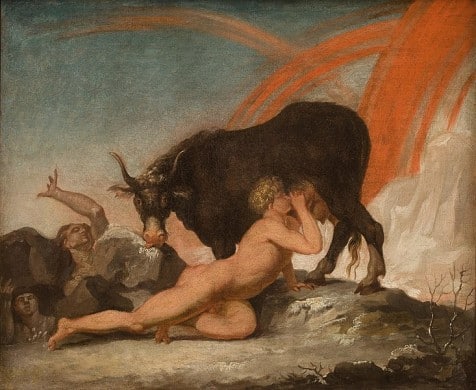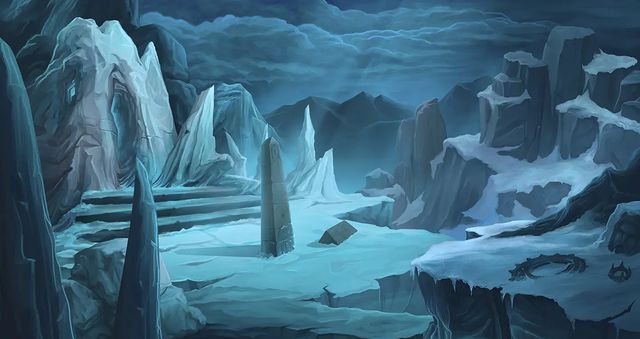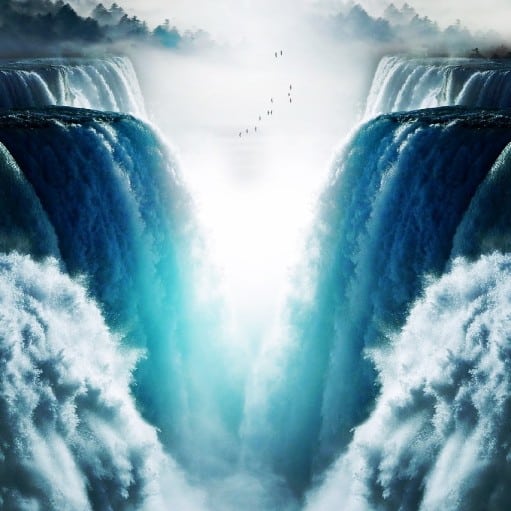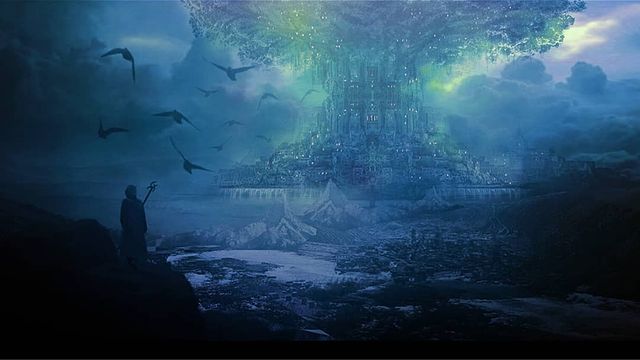In this post, we’re heading to a realm shrouded in mist and frost, a place that’s as fascinating as it is chilling. This is Niflheim, one of the two primordial realms in the Norse cosmos. The name Niflheim, in Old Norse, translates to “Mist Home” or “Mist World”. It’s a realm that stands in stark contrast to its fiery counterpart, Muspelheim.
Now, picture this: a world of ice and frost, a place where the air is so cold, it bites at your skin. It’s like stepping into a winter wonderland, but without the cozy fires and hot cocoa. Intrigued? I thought you might be 🙂
Understanding Norse Cosmology
Let’s take a step back and look at the bigger picture of Norse cosmology. At the dawn of time, there were two realms: Muspelheim, a realm of heat and fire, and Niflheim, a realm of ice and mist. These two realms existed in isolation, separated by a vast void known as Ginnungagap.
Now, imagine the sparks from Muspelheim meeting the ice of Niflheim in Ginnungagap. From this clash of elements, life was born. The frost from Niflheim melted to form a being known as Ymir, the first of the frost giants. Ymir was a primordial being, born of ice and snow, and from him, the race of frost giants came into existence.

But Ymir wasn’t the only being to emerge from the melting ice. There was also Audhumla, the cosmic cow. Audhumla was a creature of abundance and nourishment. She fed Ymir with her milk, and she herself fed on a block of salty ice. As she licked the ice, another being was revealed. This was Buri, the first of the Aesir gods. Buri was the grandfather of Odin, who would become the chief of the Aesir gods.
The creation of Ymir, Audhumla, and Buri from the interaction of Niflheim and Muspelheim is a testament to the primal power of these realms. It’s a tale of life emerging from the interplay of fire and ice, a theme that resonates throughout Norse cosmology.
Niflheim: A Realm Apart from Hel or Helheim
In my opinion, there is a common misconception that often arises in discussions about Norse mythology. That is when Niflheim and Hel, or alternatively Helheim or Niflhel, are all lumped together as one realm.
Niflheim, or Niflheimr, really only exists in the stories told by Snorri Sturluson in Gylfaginning, part of his Prose Edda. Niflhel, however, is found mentioned in both Baldrs Draumar and in the Vafthruthnirsmál. Both of those poems are considerably older than Snorri’s work and at times likely were part of his inspiration.
The Norse myths and sagas often pose challenges in sometimes being contradictory, not wholly coherent and sometimes missing important parts. This challenge was also likely faced by Snorri himself when he wrote the Prose Edda. He did so almost two hundred years after the Viking Age as we recognize it had ended, as a Christian.
The notion of “The Nine Realms” also proves somewhat difficult when you start listing the realms. Asgard, Midgard, Jotunheim, Alfheim, Svarttalfheim, Vanaheim, Muspelheim, Niflheim and Hel are the nine realms. However, they would only be eight if Hel and Niflheim were combined.
Conversely, we could flip it around a bit and say Snorri is wrong to equate Hel with Niflheim. We simultaneously need him to be right when “inventing” Niflheim in the first place, otherwise, what are the nine realms?
I think Niflheim as a realm and part of the creation myth lived in storytelling before Snorri wrote about it. However, it does seem he sometimes either mixed them up, or saw Hel as a separate realm, but inside Niflheim. This resembles Greek myths of Hades and Tartarus, and makes some sense as we know Snorri knew Greek mythology well.
What is Niflheim then?
Niflheim is a realm of frost and mist, a place of biting cold and eternal winter. It’s a harsh environment, but it’s also a place of primordial power and ancient wisdom. The dragon Nidhoggr and his brood reside here, gnawing at the roots of Yggdrasil.
On the other hand, Hel is the realm of the dead, ruled by the goddess Hel. It’s a place where some of the dead go, but not necessarily just the sick and old as stated by Snorri. The dead might actually move on to several different places, Hel being just one of them.
Overall, the confusion in part stems from Snorri Sturluson’s writings, where he sometimes used Niflheim and Hel interchangeably. However, it’s important to remember that while these realms are interconnected in the grand tapestry of Norse mythology, they are distinct entities with their own unique characteristics and inhabitants.
The Landscape of Niflheim

Imagine, if you will, standing at the northernmost tip of Norway, where the Arctic Ocean stretches out before you, a vast expanse of icy water. The air is so cold it takes your breath away, and the ground beneath your feet is hard with frost. Now, imagine that the sun never rises, that you’re enveloped in a perpetual twilight, the sky above you a tapestry of stars and shimmering auroras. This is what it might feel like to step into Niflheim, the realm of frost and mist in Norse mythology.
Niflheim is a realm of eternal winter, a place where the cold is so intense, it’s almost a physical presence. It’s like the far north of Norway or the icy landscapes of Iceland, but magnified a hundredfold. The air is thick with mist, obscuring your vision and muffling the sounds of the realm. It’s a place of solitude and silence, a stark contrast to the bustling cities and towns we’re used to.
Yet, despite its harsh conditions, Niflheim is a place of primal beauty. The rivers that flow from Hvergelmir cut through the icy landscape, their waters shimmering in the faint light. The frost that covers the ground sparkles like a blanket of diamonds, and the auroras that dance across the sky paint the realm in hues of green and blue. It’s a realm that’s as breathtaking as it is chilling, a testament to the raw, untamed power of nature.
Hvergelmir: The Roaring Well

At the heart of Niflheim lies Hvergelmir, the roaring well. This well is the source of all the rivers in Niflheim, a beacon of life in the midst of the frosty desolation. But the waters of Hvergelmir are not like the waters we’re used to. They’re not fed by rain or melting snow, but by the liquid that drips from the antlers of Eikthyrnir. He is a giant stag that stands atop Valhalla, the hall of the slain, eating leaves from Yggdrasil.
Eikthyrnir is a creature of remarkable power. From his antlers flow great amounts of liquid, which fall into Hvergelmir and become the rivers of Niflheim. These rivers, with names like Svol, Gunnthra, Fiorm, Fimbulthul, Slidr, and Hrid, flow throughout the nine worlds, carrying with them the primal power of Niflheim. One of these rivers, the Gjöll, actually separates the realm Hel from the other realms. This supports the notion that Hel and Niflheim are in fact separate realms, divided as they are by the river.
The rivers of Niflheim are not just bodies of water. They’re lifelines, bringing water far outside the realm. They’re also pathways, routes that the spirits of the dead must navigate on their journey to the afterlife. These rivers, born from Hvergelmir, are a testament to the enduring power of creation, a symbol of life in a realm of frost and mist.
Niflheim in the Eddas
Niflheim is only mentioned in the Gylfaginning section of the Prose Edda, the manuscript written by Snorri Sturluson around 1220’s. In this text, Niflheim is depicted as a realm of frost and mist, a place of primal power. Together with Muspelheim it sets the stage for the very creation of the cosmos. It’s interesting to note that Niflheim is absent in other Old Norse manuscripts as discussed before. This could suggest that its significance was particularly emphasized by Sturluson and that his sources have been lost. However, it could also mean that there are no other sources than Snorri himself.
In the Gylfaginning, Niflheim is described as one of the two original realms, along with Muspelheim. It’s depicted as a place of eternal cold and darkness, where the dragon Níðhöggr resides. This portrayal of Niflheim as a realm of primal forces and ancient wisdom is a key aspect of its role in Norse cosmology.
Interpretations and Symbolism of Niflheim

In the grand tapestry of Norse cosmology, Niflheim is a symbol of primal forces and the harsh realities of nature. It’s a realm of frost and mist, a stark contrast to the fiery Muspelheim. This duality reflects the Norse understanding of the world: a balance of opposing forces, a dance of fire and ice.
In comparison to the other realms, Niflheim represents the concept of the “outside” or the “wild”, a place beyond the safety of the gard, or enclosure. It’s a realm of primal chaos and ancient wisdom, both a source and possible threat to all life.
Parting thoughts
In conclusion, Niflheim is a realm of frost and mist, a place of primal power and ancient wisdom. It’s one of the two primordial realms in Norse mythology, standing in stark contrast to the fiery Muspelheim. Despite the common misconceptions, Niflheim is a distinct entity from Hel, otherwise sometimes called Helheim. and Helheim.
It is challenging to tie a nice bow on the discussion of how, and where Niflheim fits in. I have tried to navigate these challenges while explaining why I believe what I do, others might have a different opinion though.
The realm of Niflheim is a testament to the richness and complexity of Norse mythology, a reflection of the ancient Norse understanding of the world. It’s a realm that continues to fascinate us, a place that invites us to delve deeper into the mysteries of the Norse cosmos.
Frequently Asked Questions
In Old Norse, Niflheim translates to “Mist Home” or “Mist World”. It’s a realm characterized by frost and mist, hence the name.
Niflheim is one of the nine worlds nestled within the branches and roots of Yggdrasil, the world tree. It’s also one of the two primordial realms, along with Muspelheim, and plays a significant role in the Norse creation myth.
No, Niflheim is not the same as Hel or Helheim. Niflheim is a primordial realm of ise and mist, Hel (also called Helheim) is the Norse underworld realm of the dead.
Niflheim is a realm of eternal winter, with a landscape characterized by frost and mist. It’s home to Hvergelmir, a well from which many rivers flow.
The rivers flowing from Hvergelmir have names like Svol, Gunnthra, Fiorm, Fimbulthul, Slidr, and Hrid. These rivers carry the primal power of Niflheim, nourishing the roots of Yggdrasil, the world tree.
Niflheim is primarily inhabited by the dragon Nidhoggr and his brood of serpents. Nidhoggr and his kin are fearsome creatures who gnaw at the roots of Yggdrasil, the world tree.
Niflheim is primarily mentioned in the Gylfaginning section of the Prose Edda, where it’s depicted as a realm of frost and mist, a place of primal power.
Featured Image Credit: JoanT.V, CC BY-SA 4.0, via Wikimedia Commons
